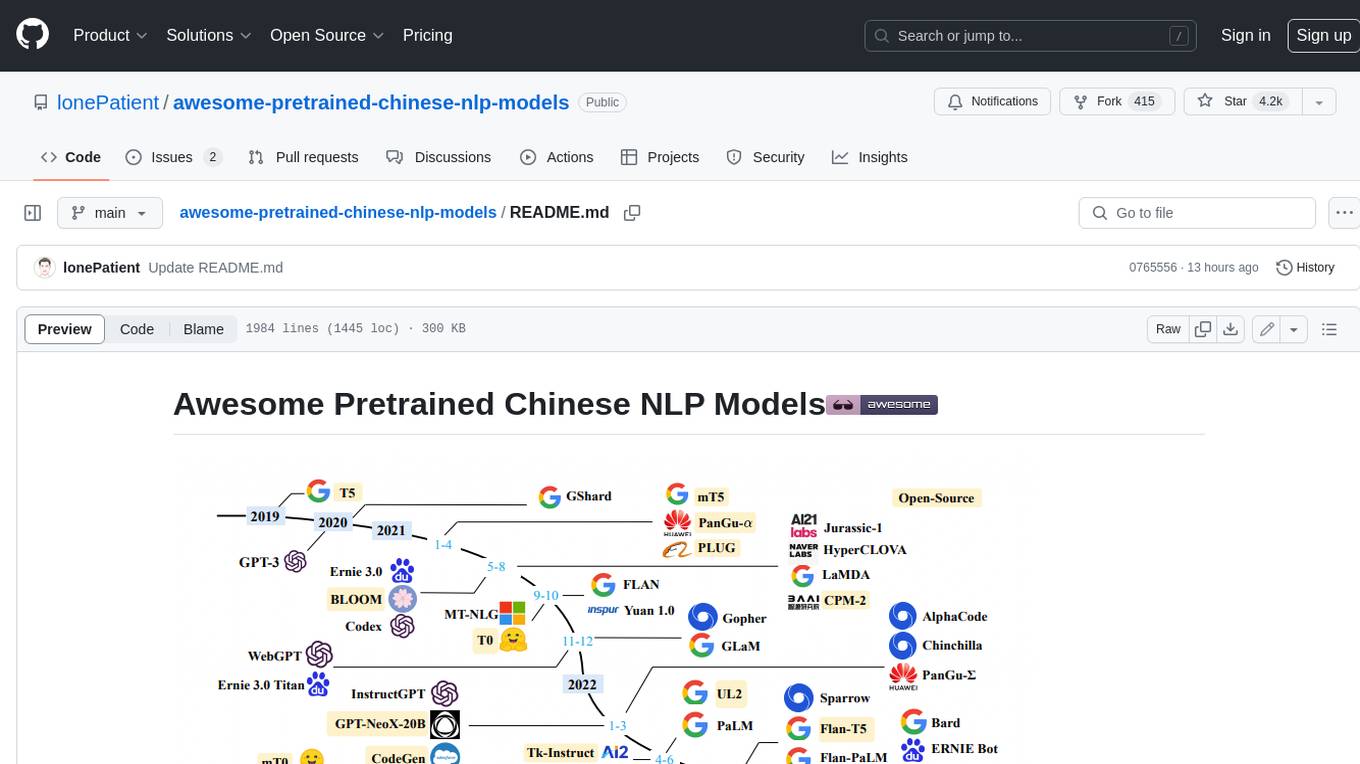
Awesome-AGI
AGI资料汇总学习(主要包括LLM和AIGC),持续更新......
Stars: 424
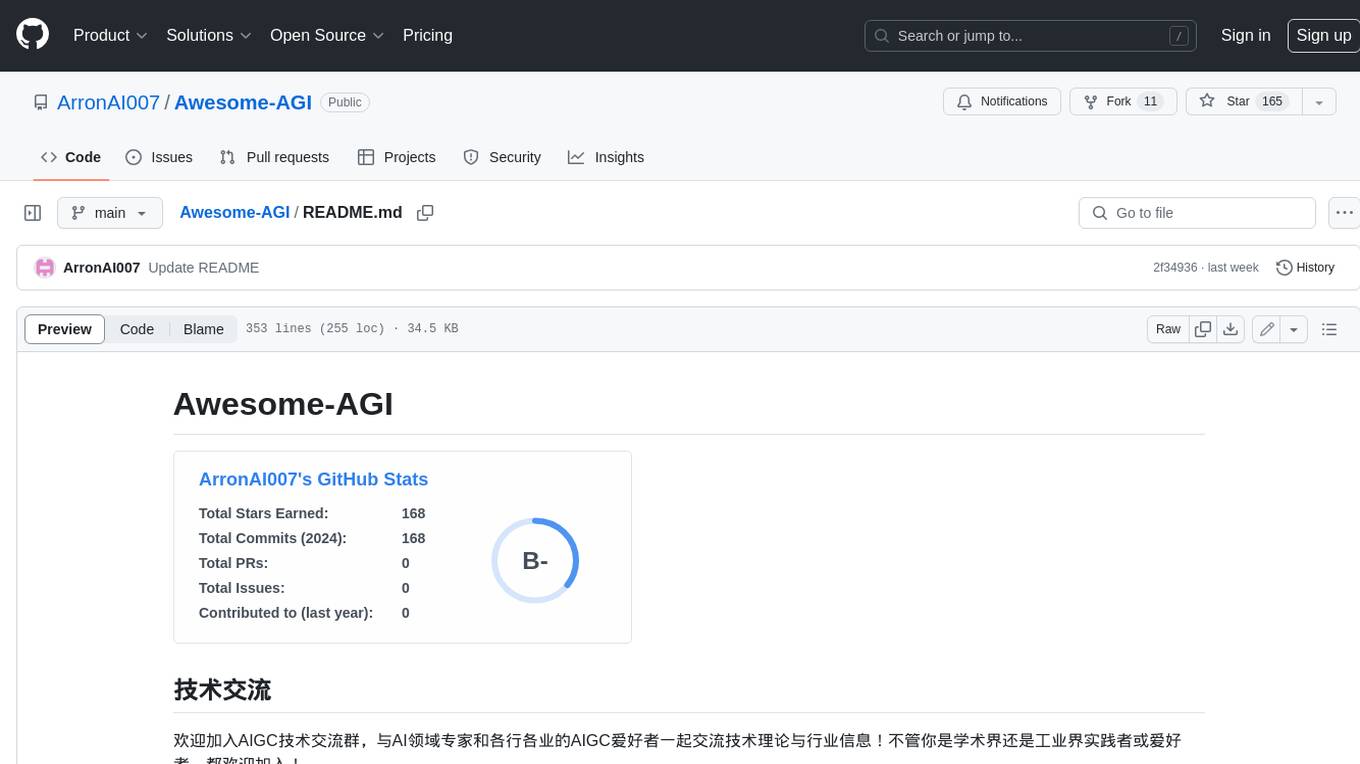
Awesome-AGI is a curated list of resources related to Artificial General Intelligence (AGI), including models, pipelines, applications, and concepts. It provides a comprehensive overview of the current state of AGI research and development, covering various aspects such as model training, fine-tuning, deployment, and applications in different domains. The repository also includes resources on prompt engineering, RLHF, LLM vocabulary expansion, long text generation, hallucination mitigation, controllability and safety, and text detection. It serves as a valuable resource for researchers, practitioners, and anyone interested in the field of AGI.
README:
欢迎加入AIGC技术交流群,与AI领域专家和各行各业的AIGC爱好者一起交流技术理论与行业信息!不管你是学术界还是工业界实践者或爱好者,都欢迎加入!
| 交流群二维码 | 拉你入群(备注AIGC-github) |
|---|---|
 |
 |
| Benchmark(Higher is better) | MMLU | TriviaQA | Natural Questions | GSM8K | HumanEval | AGIEval | BoolQ | HellaSwag | OpenBookQA | QuAC | Winogrande | MATH | MBPP | MT-Bench | Alignbench | ArenaHard | AlpacaEval2.0 |
|---|---|---|---|---|---|---|---|---|---|---|---|---|---|---|---|---|---|
| MPT(7B) | 26.8 | 59.6 | 17.8 | 6.8 | 18.3 | 23.5 | 75.0 | 76.4 | 51.4 | 37.7 | 68.3 | --- | --- | --- | --- | --- | --- |
| Falcon(7B) | 26.2 | 56.8 | 18.1 | 6.8 | --- | 21.2 | 67.5 | 74.1 | 51.6 | 18.8 | 66.3 | --- | --- | --- | --- | --- | --- |
| Llama-2(7B) | 45.3 | 68.9 | 22.7 | 14.6 | 12.8 | 29.3 | 77.4 | 77.2 | 58.6 | 39.7 | 69.2 | --- | --- | --- | --- | --- | --- |
| Llama-3-8B-Instruct | 65.8 | --- | --- | 54.7 | 61.6 | --- | --- | --- | --- | --- | --- | 21.2 | 61.4 | 8.0 | 6.2 | 20.6 | 22.9 |
| Yi-1.5-6B-chat | 62.8 | --- | --- | 78.9 | 64.0 | --- | --- | --- | --- | --- | --- | 40.5 | 70.9 | 7.5 | 6.2 | 17.9 | 15.7 |
| Yi-1.5-9B-chat | 69.5 | --- | --- | 84.8 | 66.5 | --- | --- | --- | --- | --- | --- | 47.7 | 78.8 | 8.2 | 6.9 | 34.4 | 22.9 |
| Yi-1.5-34B-Chat | 76.8 | --- | --- | 90.2 | 75.2 | --- | --- | --- | --- | --- | --- | 50.1 | 74.6 | 8.5 | 7.2 | 42.6 | 36.6 |
| gemma-1.1-7b-it | 60.9 | --- | --- | 57.5 | 41.5 | --- | --- | --- | --- | --- | --- | 24.2 | 55.6 | 7.5 | 5.0 | 7.5 | 10.4 |
| Qwen1.5-7B-Chat | 60.4 | --- | --- | 62.9 | 38.4 | --- | --- | --- | --- | --- | --- | 22.0 | 41.5 | 7.7 | 6.2 | 10.2 | 14.7 |
| Qwen1.5-32B-Chat | 74.3 | --- | --- | 83.9 | 51.2 | --- | --- | --- | --- | --- | --- | 43.3 | 66.9 | 8.3 | 7.1 | 24.2 | 23.9 |
| Qwen1.5-72B-Chat | 77.3 | --- | --- | 86.0 | 64.6 | --- | --- | --- | --- | --- | --- | 44.4 | 72.5 | 8.6 | 7.2 | 36.1 | 36.6 |
| Mistral-7B-Instruct-v0.2 | 59.2 | --- | --- | 49.2 | 23.8 | --- | --- | --- | --- | --- | --- | 13.4 | 36.5 | 7.6 | 5.3 | 12.6 | 17.1 |
| Mistral-8x7B-Instruct-v0.1 | 71.4 | --- | --- | 65.7 | 45.1 | --- | --- | --- | --- | --- | --- | 30.7 | 59.5 | 8.3 | 5.7 | 23.4 | 23.7 |
| Mistral-8x22B-Instruct-v0.1 | 77.7 | --- | --- | 84.0 | 76.2 | --- | --- | --- | --- | --- | --- | 41.1 | 73.8 | 8.6 | 6.5 | 36.4 | 30.9 |
大模型层出不穷,我对主流大模型按照如下分类体系进行分类:
1)baichuan、ChatGLM和LLaMA及其扩展模型;
2)按照通用领域(包括文本、代码、图像/视频、音频、多模态)和垂直领域(法律、医疗、金融、环境、网络安全、教育、交通以及其他)
更多请参考【Model List】。
dair-ai同样也整理了很多关于LLM和经典论文,感兴趣的读者可以参考:【ML Papers Explained】
3)国内外大模型API的调用案例,请参考【语言大模型】,【多模态大模型】和【OpenAI大模型】
LLM预训练、微调使用的部分数据集,更多请参考【DataSet】
随着ChatGPT的发布,标志着大模型时代已来临,然而通用领域的大模型在企业垂直领域中未必会表现的好,因此会对通用领域大模型进行微调来适配垂直领域知识。
大模型的微调技术,从不同的方面,有不同的分类:
从参数规模来说,可以简单分为全参数微调和高效参数微调。前者一般是用预训练模型作为初始化权重,在特定数据集上继续训练,全部参数都更新的方法。而后者则是期望用更少的资源完成模型参数的更新,包括只更新一部分参数或者说通过对参数进行某种结构化约束,例如稀疏化或低秩近似来降低微调的参数数量。
如果按照在模型哪个阶段使用微调,或者根据模型微调的目标来区分,也可以从提示微调、指令微调、有监督微调的方式来。 高效微调技术可以粗略分为以下三大类:
- 增加额外参数(Addition-Based)
- 选取一部分参数更新(Selection-Based)
- 引入重参数化(Reparametrization-Based)
而在增加额外参数这类方法中,又主要分为类适配器(Adapter-like)方法和软提示(Soft prompts)两个小类。 增加额外参数 Addition-Based,如:Prefix Tuning、Prompt Tuning、Adapter Tuning及其变体 选取一部分参数更新 Selection-Based,如:BitFit 引入重参数化 Reparametrization-Based,如:LoRA、AdaLoRA、QLoRA 混合高效微调,如:MAM Adapter、UniPELT
下图是目前主流PEFT技术的总结:
PEFT仓库是一个用于微调大模型的工具库,提供了多种高效微调技术的实现。
下面按照LoRA及其扩展模型和其他微调方法分别进行总结:
| Peft | Description | Paper | Code | Blog |
|---|---|---|---|---|
| LoRA | 1)Transformer的权重矩阵包括Attention模块里用于计算query, key, value的Wq,Wk,Wv以及多头attention的Wo,以及MLP层的权重矩阵,LoRA只应用于Attention模块中的4种权重矩阵,而且通过消融实验发现同时调整 Wq 和 Wv 会产生最佳结果。2)实验还发现,保证权重矩阵的种类的数量比起增加隐藏层维度r更为重要,增加r并不一定能覆盖更加有意义的子空间。3)关于秩的选择,通常情况下,rank为4,8,16即可。4)实验也发现,在众多数据集上LoRA在只训练极少量参数的前提下,最终在性能上能和全量微调匹配,甚至在某些任务上优于全量微调。 | LoRA: Low-Rank Adaptation of Large Language Models | LoRA Code | |
| LoRA+ | LoRA+通过为矩阵a和b引入不同的学习率,矩阵B的初始化为0,所以需要比随机初始化的矩阵a需要更大的更新步骤。通过将矩阵B的学习率设置为矩阵A的16倍,作者已经能够在模型精度上获得小幅提高(约2%),同时将RoBERTa或lama-7b等模型的训练时间加快2倍。 | LoRA+: Efficient Low Rank Adaptation of Large Models | ||
| AdaLoRA | AdaLoRA是对LoRA的一种改进,它根据重要性评分动态分配参数预算给权重矩阵。具体做法如下:1)调整增量矩分配。AdaLoRA将关键的增量矩阵分配高秩以捕捉更精细和任务特定的信息,而将较不重要的矩阵的秩降低,以防止过拟合并节省计算预算。2)以奇异值分解的形式对增量更新进行参数化,并根据重要性指标裁剪掉不重要的奇异值,同时保留奇异向量。由于对一个大矩阵进行精确SVD分解的计算消耗非常大,这种方法通过减少它们的参数预算来加速计算,同时,保留未来恢复的可能性并稳定训练。3)在训练损失中添加了额外的惩罚项,以规范奇异矩阵P和Q的正交性,从而避免SVD的大量计算并稳定训练。 | AdaLoRA: Adaptive Budget Allocation for Parameter-Efficient Fine-Tuning | AdaLoRA Code | |
| QLoRA | QLoRA使用一种新颖的高精度技术将预训练模型量化为 4 bit,然后添加一小组可学习的低秩适配器权重,这些权重通过量化权重的反向传播梯度进行微调。QLORA 有一种低精度存储数据类型(4 bit),还有一种计算数据类型(BFloat16)。实际上,这意味着无论何时使用 QLoRA 权重张量,我们都会将张量反量化为 BFloat16,然后执行 16 位矩阵乘法。QLoRA提出了两种技术实现高保真 4 bit微调——4 bit NormalFloat(NF4) 量化和双量化。此外,还引入了分页优化器,以防止梯度检查点期间的内存峰值,从而导致内存不足的错误,这些错误在过去使得大型模型难以在单台机器上进行微调。 | QLoRA: Efficient Finetuning of Quantized LLMs | QLoRA Code | |
| DoRA | DoRA(Weight-Decomposed Low-Rank Adaptation:权重分解低阶适应)是由NVIDIA最新提出的一种新的参数高效的微调(PEFT)方法。DoRA旨在通过分解预训练权重为幅度(magnitude)和方向(direction)两个组成部分然后分别微调,来提高微调的学习能力和训练稳定性,同时避免额外的推理开销,它特别适用于与LoRA(Low-Rank Adaptation)结合使用。 | DoRA: Weight-Decomposed Low-Rank Adaptation | DoRA Code | |
| PiSSA方法 | 仅修改Lora初始化方式显著提高模型微调效果 | PiSSA: Principal Singular Values and Singular Vectors Adaptation of Large Language Models | PiSSA Code | PiSSA Blog |
| MOELora | MOELoRA 的核心思想是将 MOE 和 LoRA 结合起来,以实现多任务学习和参数高效微调。MOELoRA 由两个主要组件组成:MOE 和 LoRA。MOE 用于多任务学习,LoRA 用于参数高效微调。MOELoRA 通过 MOE 的多任务学习能力,有效地利用了有限的数据和计算资源,同时通过 LoRA 的参数高效微调能力,有效地提高了多任务医学应用的性能。 | MOELoRA: An MOE-based Parameter Efficient Fine-Tuning Method for Multi-task Medical Applications | MOELora Code | |
| LoRA-FA | LoRA-fa,是LoRA与Frozen-A的缩写,在LoRA-FA中,矩阵A在初始化后被冻结,因此作为随机投影。矩阵B不是添加新的向量,而是在用零初始化之后进行训练(就像在原始LoRA中一样)。这将参数数量减半,同时具有与普通LoRA相当的性能。 | [LoRA-FA: Memory-efficient Low-rank Adaptation for Large Language Models Fine-tuning | ||
| ](https://arxiv.org/abs/2308.03303) | ||||
| LoRa-drop | Lora矩阵可以添加到神经网络的任何一层。LoRA-drop则引入了一种算法来决定哪些层由LoRA微调,哪些层不需要。 | LoRA-drop: Efficient LoRA Parameter Pruning based on Output Evaluation | ||
| Delta-LoRA | Delta-LoRA的作者提出用AB的梯度来更新矩阵W, AB的梯度是A*B在连续两个时间步长的差。这个梯度用超参数λ进行缩放,λ控制新训练对预训练权重的影响应该有多大。 | Delta-LoRA: Fine-Tuning High-Rank Parameters with the Delta of Low-Rank Matrices |
| Peft | Description | Paper | Code | Blog |
|---|---|---|---|---|
| Instruction Tuning | 指令微调可以被视为有监督微调(Supervised Fine-Tuning,SFT)的一种特殊形式。但是,它们的目标依然有差别。SFT是一种使用标记数据对预训练模型进行微调的过程,以便模型能够更好地执行特定任务。而指令微调是一种通过在包括(指令,输出)对的数据集上进一步训练大型语言模型(LLMs)的过程,以增强LLMs的能力和可控性。 | nstruction Tuning for Large Language Models: A Survey | Instruction Tuning Code | |
| BitFit | BitFit是一种稀疏的微调方法,它训练时只更新bias的参数或者部分bias参数 | BitFit: Simple Parameter-efficient Fine-tuning for Transformer-based Masked Language-models | BitFit Code | |
| Prefix Tuning | Prefix Tuning提出固定预训练LM,为LM添加可训练,任务特定的前缀,这样就可以为不同任务保存不同的前缀,微调成本也小;同时,这种Prefix实际就是连续可微的Virtual Token(Soft Prompt/Continuous Prompt),相比离散的Token,更好优化,效果更好。 | Prefix-Tuning: Optimizing Continuous Prompts for Generation | Prefix Tuning Code | |
| Prompt Tuning | Prompt Tuning,该方法可以看作是Prefix Tuning的简化版本,它给每个任务定义了自己的Prompt,然后拼接到数据上作为输入,但只在输入层加入prompt tokens,并且不需要加入 MLP 进行调整来解决难训练的问题。 | The Power of Scale for Parameter-Efficient Prompt Tuning | Prompt Tuning Code | |
| P-Tuning | P-Tuning,设计了一种连续可微的virtual token(同Prefix-Tuning类似)。将Prompt转换为可以学习的Embedding层,并用MLP+LSTM的方式来对Prompt Embedding进行一层处理。借助P-tuning,GPT在SuperGLUE上的成绩首次超过了同等级别的BERT模型,这颠覆了一直以来“GPT不擅长NLU”的结论,也是该论文命名的缘由。 | GPT Understands, Too | P-Tuning Code | |
| P-Tuning V2 | P-Tuning 的问题是在小参数量模型上表现差。 相比 Prompt Tuning 和 P-tuning 的方法, P-tuning v2 方法在每一层加入了 Prompts tokens 作为输入。与P-Tuning相比,做了如下改变:1)移除重参数化的编码器;2)针对不同任务采用不同的提示长度;3)引入多任务学习;4)回归传统的分类标签范式,而不是映射器 | P-Tuning v2: Prompt Tuning Can Be Comparable to Fine-tuning Universally Across Scales and Tasks | P-Tuning-V2 Code | |
| Adapter Tuning | Adapter 在预训练模型每层中插入用于下游任务的参数(针对每个下游任务,仅增加3.6%的参数),在微调时将模型主体冻结,仅训练特定于任务的参数,从而减少了训练时的算力开销。Adapter Tuning 设计了Adapter结构,并将其嵌入Transformer的结构里面,针对每一个Transformer层,增加了两个Adapter结构,分别是多头注意力的投影之后和第二个feed-forward层之后。在训练时,固定住原来预训练模型的参数不变,只对新增的 Adapter 结构和 Layer Norm 层进行微调,从而保证了训练的高效性。 | Parameter-Efficient Transfer Learning for NLP | Adapter Tuning Code | |
| AdapterFusion | Adapter Fusion,一种融合多任务信息的Adapter的变体,在 Adapter 的基础上进行优化,通过将学习过程分为两阶段来提升下游任务表现。1)知识提取阶段:在不同任务下引入各自的Adapter模块,用于学习特定任务的信息。2)知识组合阶段:将预训练模型参数与特定任务的Adapter参数固定,引入新参数(AdapterFusion)来学习组合多个Adapter中的知识,以提高模型在目标任务中的表现。 | AdapterFusion: Non-Destructive Task Composition for Transfer Learning | ||
| AdapterDrop | 作者通过对Adapter的计算效率进行分析,发现与全量微调相比,Adapter在训练时快60%,但是在推理时慢4%-6%。基于此,作者提出了AdapterDrop方法缓解该问题。AdapterDrop 在不影响任务性能的情况下,对Adapter动态高效的移除,尽可能的减少模型的参数量,提高模型在反向传播(训练)和正向传播(推理)时的效率。 | AdapterDrop: On the Efficiency of Adapters in Transformers | ||
| MAM Adapter | MAM Adapter,一个在Adapter、Prefix Tuning和LoRA之间建立联系的统一方法。模型 MAM Adapter 是用 FFN 层的并行Adapter和软提示的组合。 | Towards a Unified View of Parameter-Efficient Transfer Learning | MAM Adapter Code | |
| UniPELT | UniPELT方法将不同的PELT方法作为子模块,并通过门控机制学习激活最适合当前数据或任务的方法。 | UniPELT: A Unified Framework for Parameter-Efficient Language Model Tuning | UniPELT Code |
这里整理关于LLM微调的脚本以及开源工具或者平台的使用案例,更多请参考【Fine Tune】
| Description | Paper | Code | Blog |
|---|---|---|---|
| BentoML | BentoML Code | ||
| CLIP-API-service | |||
| CTranslate2 | |||
| DeepSpeed-MII | |||
| FastLLM | |||
| Huggingface | |||
| JittorLLM | |||
| LightLLM | |||
| LMDeploy | |||
| MLC LLM | |||
| OneDiffusion | |||
| OpenLLM | |||
| Ray Serve |
【LLM大语言模型之Generate/Inference(生成/推理)中参数与解码策略原理及其代码实现】【blog】
| Description | Paper | Code | Blog |
|---|---|---|---|
| ColossalAI | ColossalAI Code | ||
| DeepSpeed | |||
| Megatron-LM |
RAG实战与理论相关资料,更多请参考【LangChain】
RAG实战主要分为LangChain框架实现和LlamaIndex框架实现,分别可以参考LangChain_RAG和LlamaIndex_RAG
| VectorDB | Paper | Code | Blog |
|---|---|---|---|
| Chroma | |||
| DingoDB | dingo,dingo-store | DingoDB官网 | |
| LanceDB | |||
| Milvus | |||
| Pinecone | |||
| QDrant | |||
| Weaviate | |||
| Zilliz |
| RAG_OpenSoure_Tool | Code | Blog |
|---|---|---|
| AnythingLLM | AnythingLLM Code | AnythingLLM官网 |
| QAnything | QAnything Code |
| Model | Description | Code | Paper/Blog |
|---|---|---|---|
| Agents | Agent Code | Agents: An Open-source Framework for Autonomous Language Agents,Agent 官网,blog | |
| AgentGPT | AgentGPT Code | AgentGPT Chat,AgentGPT docs | |
| AgentVerse | |||
| AI Legion | AI Legion Chat | ||
| AutoGen | 微软在向 OpenAI 注资 130 亿美元并使 Bing 变得更智能后,现在成为人工智能领域的主要参与者。其 AutoGen 是一个用于开发和部署多个代理的开源框架,这些代理可以共同工作以自主实现目标。AutoGen 试图促进和简化代理之间的通信,减少错误,并最大化 LLMs 的性能。它还具有广泛的定制功能,允许您选择首选模型,通过人类反馈改进输出,并利用额外的工具。 | AutoGen blog | |
| AutoGPT | 创始人托兰·布鲁斯·理查兹开发,AutoGPT 是早期代理之一,于 2023 年 3 月发布,是根据中岛的论文开发的。它也是今天在 GitHub 上最受欢迎的代理存储库。 AutoGPT 的理念很简单 - 它是一个完整的工具包,用于构建和运行各种项目的定制 AI 代理。该工具使用 OpenAI 的 GPT-4 和 GPT-3.5 大型语言模型(LLM),并允许您为各种个人和商业项目构建代理。 | AutoGPT Code | AutoGPT docs ,AutoGPT blog |
| BabyAGI | BabyAGI 是中山的任务驱动自主代理的简化版本。这个 Python 脚本只有 140 个代码字,并且根据官方 GitHub 仓库,“使用 OpenAI 和矢量数据库,如 Chroma 或 Weaviate,来创建、优先处理和执行任务”。 | BabyAGI Code | BabyAGI docs |
| Camel | 该框架利用 LLM 的力量动态分配角色给代理人,指定和开发复杂任务,并安排角色扮演场景,以促进代理人之间的协作。这就像是为人工智能设计的戏剧。 | CAMEL Code | CAMEL Chat,CAMEL docs |
| ChatDev | CoPilot、Bard、ChatGPT 等等都是强大的编码助手。但是像 ChatDev 这样的项目可能很快就会让它们望尘莫及。ChatDev 被打造成“一个虚拟软件公司”,它不仅使用一个,而是多个代理人来扮演传统开发组织中的不同角色。 代理人 - 每个都被分配了一个独特的角色 - 可以合作处理各种任务,从设计软件到编写代码和文档。雄心勃勃?当然。ChatDev 仍然更多地是一个代理人互动的测试平台,但如果你自己是开发人员,它是值得一看的。 | ChatDev Code | |
| crewAI | crewAI Code | crewAI Blog | |
| CogAgent | |||
| Do Anything Machine | Do Anything Machine Chat | ||
| FixAgent | 一款自动化debug的多Agent应用,有效提升模型20% debug能力 | A Unified Debugging Approach via LLM-Based Multi-Agent Synergy,FixAgent Blog | |
| Generative Agents | GPTRPG Code | Generative Agents: Interactive Simulacra of Human Behavior | |
| Gentopia | |||
| Godmode | Godmode Chat | ||
| GPT-Engineer | GPT-Engineer Code | ||
| HuggingGPT | HuggingGPT Code | HuggingGPT Chat | |
| JARVIS | JARVIS 远不及托尼·斯塔克标志性的人工智能助手(还有同样标志性的保罗·贝坦尼的声音),但它有一些小技巧。以 ChatGPT 作为其“决策引擎”,JARVIS 处理任务规划、模型选择、任务执行和内容生成。拥有对 HuggingFace 平台上数十种专门模型的访问权限,JARVIS 利用 ChatGPT 的推理能力来应用最佳模型到给定的任务上。这使得它对各种任务具有相当迷人的灵活性,从简单的摘要到目标检测都能胜任。 | JARVIS Code | --- |
| LoopGPT | LoopGPT 是 Toran Bruce Richards 的 AutoGPT 的一个迭代版本。除了一个合适的 Python 实现,该框架还带来了对 GPT-3.5 的改进支持,集成和自定义代理能力。它还消耗更少的 API 令牌,因此运行成本更低。LoopGPT 可以基本上自主运行,或者与人类一起运行,以最小化模型的幻觉。有趣的是,该框架不需要访问向量数据库或外部存储来保存数据。它可以将代理状态写入文件或 Python 项目。 | LoopGPT Code | |
| MetaGPT | MetaGPT 是另一个开源 AI 代理框架,试图模仿传统软件公司的结构。与 ChatDev 类似,代理被分配为产品经理、项目经理和工程师的角色,并协作完成用户定义的编码任务。到目前为止,MetaGPT 只能处理中等难度的任务 - 比如编写贪吃蛇游戏或构建简单的实用应用程序 - 但它是一个有前途的工具,可能在未来迅速发展。使用 OpenAI API 费用,生成一个完整的项目大约需要 2 美元。 | MetaGPT Code | |
| NexusGPT | NexusGPT Chat | ||
| OpenAGI | OpenAGI 是一个开源的 AGI(人工通用智能)研究平台,结合了小型专家模型 - 专门针对情感分析或图像去模糊等任务的模型 - 以及来自任务反馈的强化学习(RLTF)来改进它们的输出。 在幕后,OpenAGI 与其他自主开源 AI 框架并没有太大的不同。它汇集了像 ChatGPT、LLMs(如 LLaMa2)和其他专业模型等流行平台,并根据任务的上下文动态选择合适的工具。 | OpenAGI Code | |
| RecurrentGPT | |||
| RestGPT | RestGPT Code | RestGPT blog,RestGPT: Connecting Large Language Models with Real-World RESTful APIs | |
| RoboGen | RoboGen Code | 项目主页,blog,RoboGen: Towards Unleashing Infinite Data for Automated Robot Learning via Generative Simulation | |
| ShortGPT | AI 模型在生成内容方面表现出色。但直到最近,视频格式一直受到较少关注。ShortGPT 是一个框架,它允许您使用大型语言模型来简化诸如视频创作、语音合成和编辑等复杂任务。 ShortGPT 可以处理大多数典型的与视频相关的任务,如撰写视频脚本,生成配音,选择背景音乐,撰写标题和描述,甚至编辑视频。该工具适用于短视频和长视频内容,无论平台如何。 | ShortGPT Code | |
| SuperAGI | SuperAGI 是 AutoGPT 的更灵活、用户友好的替代品。把它想象成一个开源 AI 代理的发射台,它包含了构建、维护和运行自己代理所需的一切。这还包括插件和一个云版本,您可以在其中测试各种功能。该框架具有多个人工智能模型,图形用户界面,与向量数据库的集成(用于存储/检索数据),以及性能洞察。还有一个市场,其中有工具包,可以让您将其连接到流行的应用程序和服务,如 Google Analytics。 | SuperAGI Code | |
| Toolformer | Toolformer blog,Toolformer: Language Models Can Teach Themselves to Use Tools | ||
| XAgent | XAgent Code | XAgent官网,XAgent Blog | |
| Xlang |
关于LangChain的相关笔记和课程,更多请参考【LangChain】
LangSmith允许您调试、测试、评估和监控构建在任何LLM框架上的链和智能代理,并与LangChain无缝集成。【平台入口】,【官方文档地址】。更多实战案例代码请参考【LangSmith实战案例】
LangFuse是LangSmith的平替,【官方网站】,【项目地址】。更多实战代码请参考【LangFuse】
整理关于LlamaIndex的相关笔记和课程,更多请参考【LlamaIndex】
整理关于TaskingAI的相关笔记和课程,更多请参考【TaskingAI】
更多请参考【Prompt Engineering】
| Description | Paper | Code | Blog |
|---|---|---|---|
| 复现RLHF:通过开源项目 trl 搭建一个通过强化学习算法(PPO)来更新语言模型(GPT-2) | code | blog | |
| 详解大模型RLHF过程(配代码解读) | blog | ||
| 想训练ChatGPT?得先弄明白Reward Model怎么训(附源码) | blog | ||
| 直接偏好优化算法(Direct Preference Optimization,DPO) | Direct Preference Optimization: Your Language Model is Secretly a Reward Model | DPO Code | DPO Code |
【LLM大模型之基于SentencePiece扩充LLaMa中文词表实践】【blog】
由于大模型大部分都是基于Transformer架构的,而Transformer的二次复杂度导致大模型上下文长度受限,然而最近出现很多调整Transformer架构,比如Mamba。
| Description | Paper | Code | Blog |
|---|---|---|---|
| Transformer升级之路:一种全局长度外推的新思路 | blog | ||
| ChatGPT能写长篇小说了,ETH提出RecurrentGPT实现交互式超长文本生成 | paper | code | blog,demo1,demo2 |
| 语言大模型100K上下文窗口的秘诀 | blog | ||
| RoPE可能是LLM时代的Resnet | blog | ||
| 图解RoPE旋转位置编码及其特性 | blog | ||
| 详解基于调整RoPE旋转角度的大模型长度外推方法 | blog | ||
| 无需微调的自扩展大模型上下文窗口 | LLM Maybe LongLM: Self-Extend LLM Context Window Without Tuning | --- | --- |
| 大模型长文本评估方案CLongEval | CLongEval: A Chinese Benchmark for Evaluating Long-Context Large Language Models | CLongEval Code | CLongEval Blog |
| Infini-Transformer | |||
| MEGALODON | MEGALODON: Efficient LLM Pretraining and Inference with Unlimited Context Length | MEGALODON Code | MEGALODON Blog |
| LongRoPE:将大模型上下文窗口扩展超过200万tokens | LongRoPE: Extending LLM context window beyond 2 million tokens | LongRoPE Blog |
解决幻觉常用的两种方法:1)不断增加模型的数据规模、提升数据质量;2)通过调用搜索等外部工具让模型能够获取实时信息。
| Description | Paper | Code | Blog |
|---|---|---|---|
| 腾讯AILab等《大型语言模型中的幻觉》,全面阐述检测、解释和减轻幻觉 | Siren's Song in the AI Ocean: A Survey on Hallucination in Large Language Models | code | blog |
| LLM幻觉的解决方案及其应用 | Cognitive Mirage: A Review of Hallucinations in Large Language Models | code | blog |
| Description | Paper | Code | Blog |
|---|---|---|---|
| 微软提出Control-GPT:用GPT-4实现可控文本到图像生成! | paper | blog | |
| AIGC如何安全可控?中山大学等最新《AIGC中对隐私和安全的挑战及其补救措施:探索隐私计算、区块链潜在应用》全面阐述 | paper | blog | |
| ControlVideo: 可控的Training-free的文本生成视频 | paper | code | blog |
| 大模型切脑后变身PoisonGPT,虚假信息案例 | code | blog | |
| ChatGPT羊驼家族全沦陷!CMU博士击破LLM护栏,人类毁灭计划脱口而出 | paper | code | blog |
| Description | Paper | Code | Blog |
|---|---|---|---|
| 美国麻省大学&谷歌研究院:改写文本可以避开AI生成文本的检测器,但检索则是一种有效的防御 | paper | code | |
| 人工智能生成的文本能被可靠地检测出来吗? | paper | blog | |
| DetectGPT(斯坦福大学):利用概率曲率检测文本是否大模型生成 | paper | code&data | blog |
| Detecting LLM-Generated-Text综述 | paper | blog | |
| 一个专为教育者打造的全新 AI 检测模型 | blog | ||
| OpenAI重磅发布官方「ChatGPT检测器」 | blog | ||
| 斯坦福最新研究:不要过度依赖GPT生成内容,其检测器可能存在不利于非母语英语写作者的偏见 | paper | ||
| TUM发布最新《检测ChatGPT生成文本现状》综述 | paper |
【👬🏻】欢迎Star ⭐️⭐️⭐️⭐️⭐️ && 提交 Pull requests 👏🏻👏🏻👏🏻
个人主页:wshzd.github.io
微信公众号:
以上部分资料来自网络整理,供大家学习参考,如有侵权,麻烦联系我删除!
WeChat:h18821656387
For Tasks:
Click tags to check more tools for each tasksFor Jobs:
Alternative AI tools for Awesome-AGI
Similar Open Source Tools

Awesome-AGI
Awesome-AGI is a curated list of resources related to Artificial General Intelligence (AGI), including models, pipelines, applications, and concepts. It provides a comprehensive overview of the current state of AGI research and development, covering various aspects such as model training, fine-tuning, deployment, and applications in different domains. The repository also includes resources on prompt engineering, RLHF, LLM vocabulary expansion, long text generation, hallucination mitigation, controllability and safety, and text detection. It serves as a valuable resource for researchers, practitioners, and anyone interested in the field of AGI.
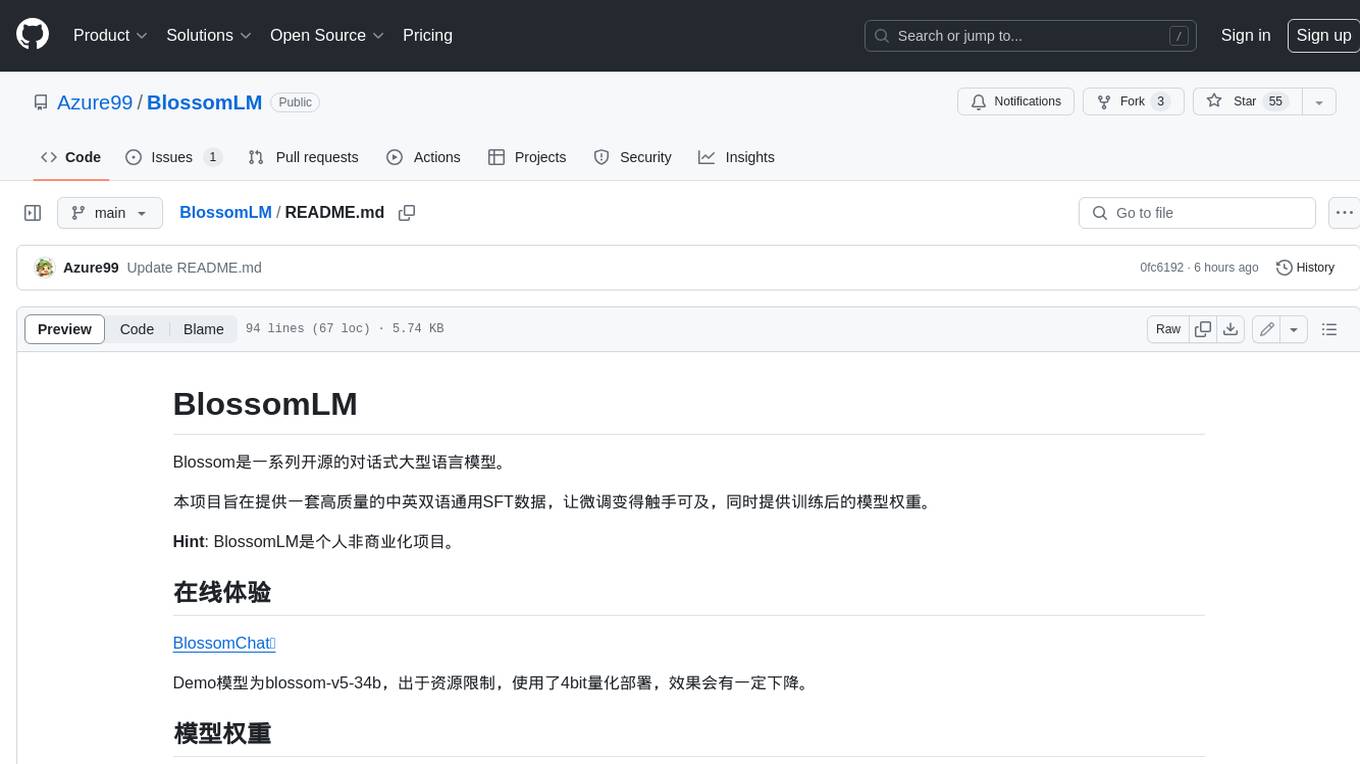
BlossomLM
BlossomLM is a series of open-source conversational large language models. This project aims to provide a high-quality general-purpose SFT dataset in both Chinese and English, making fine-tuning accessible while also providing pre-trained model weights. **Hint**: BlossomLM is a personal non-commercial project.
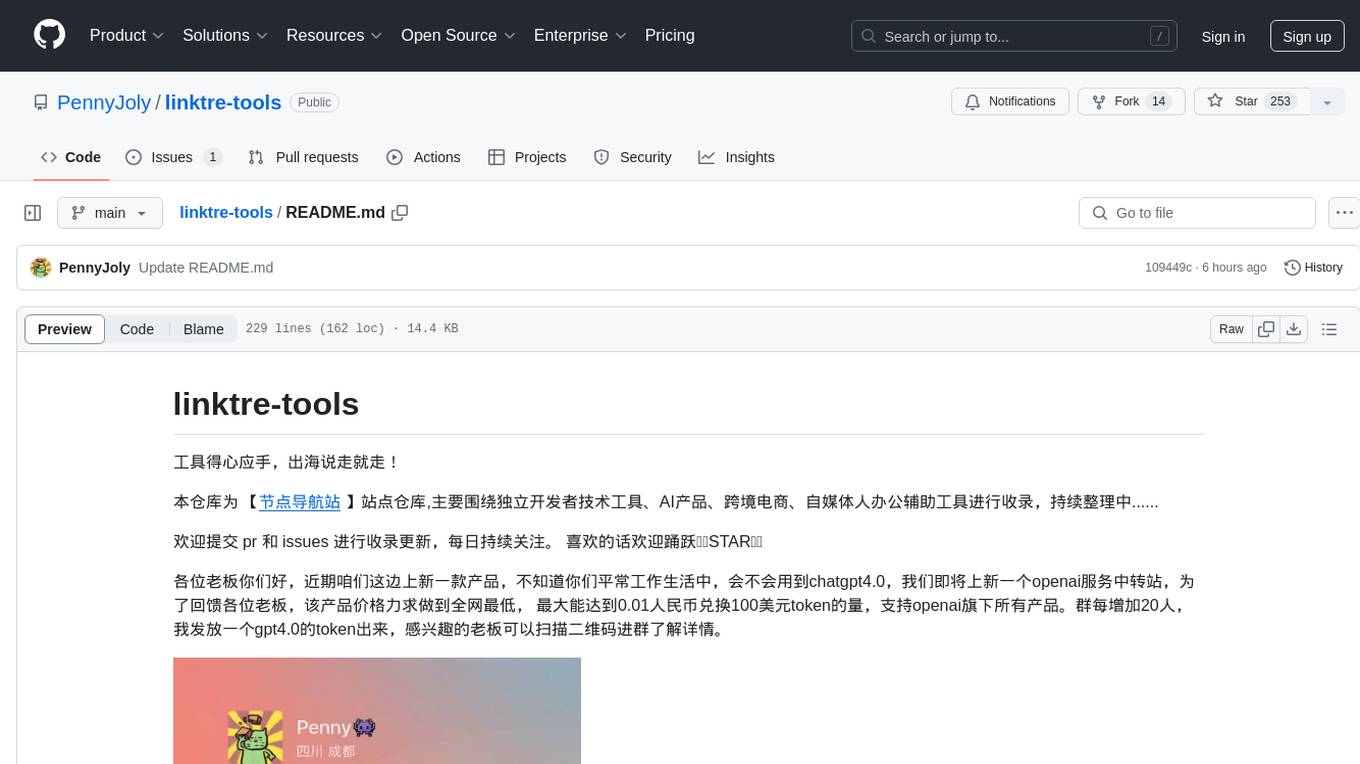
linktre-tools
The 'linktre-tools' repository is a collection of tools and resources for independent developers, AI products, cross-border e-commerce, and self-media office assistance. It aims to provide a curated list of tools and products in these areas. Users are encouraged to contribute by submitting pull requests and raising issues for continuous updates. The repository covers a wide range of topics including AI tools, independent development tools, popular AI products, tools for web development, online tools, media operations, and cross-border e-commerce resources.
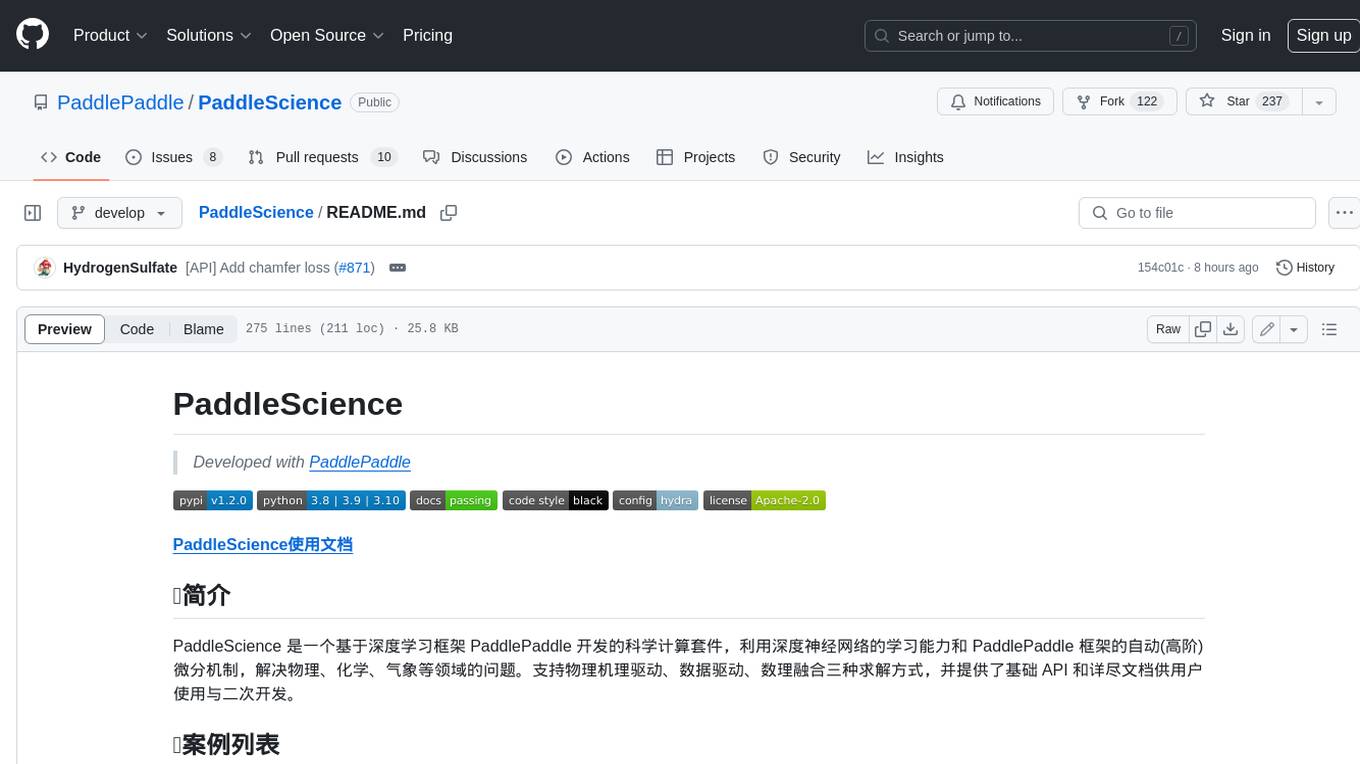
PaddleScience
PaddleScience is a scientific computing suite developed based on the deep learning framework PaddlePaddle. It utilizes the learning ability of deep neural networks and the automatic (higher-order) differentiation mechanism of PaddlePaddle to solve problems in physics, chemistry, meteorology, and other fields. It supports three solving methods: physics mechanism-driven, data-driven, and mathematical fusion, and provides basic APIs and detailed documentation for users to use and further develop.
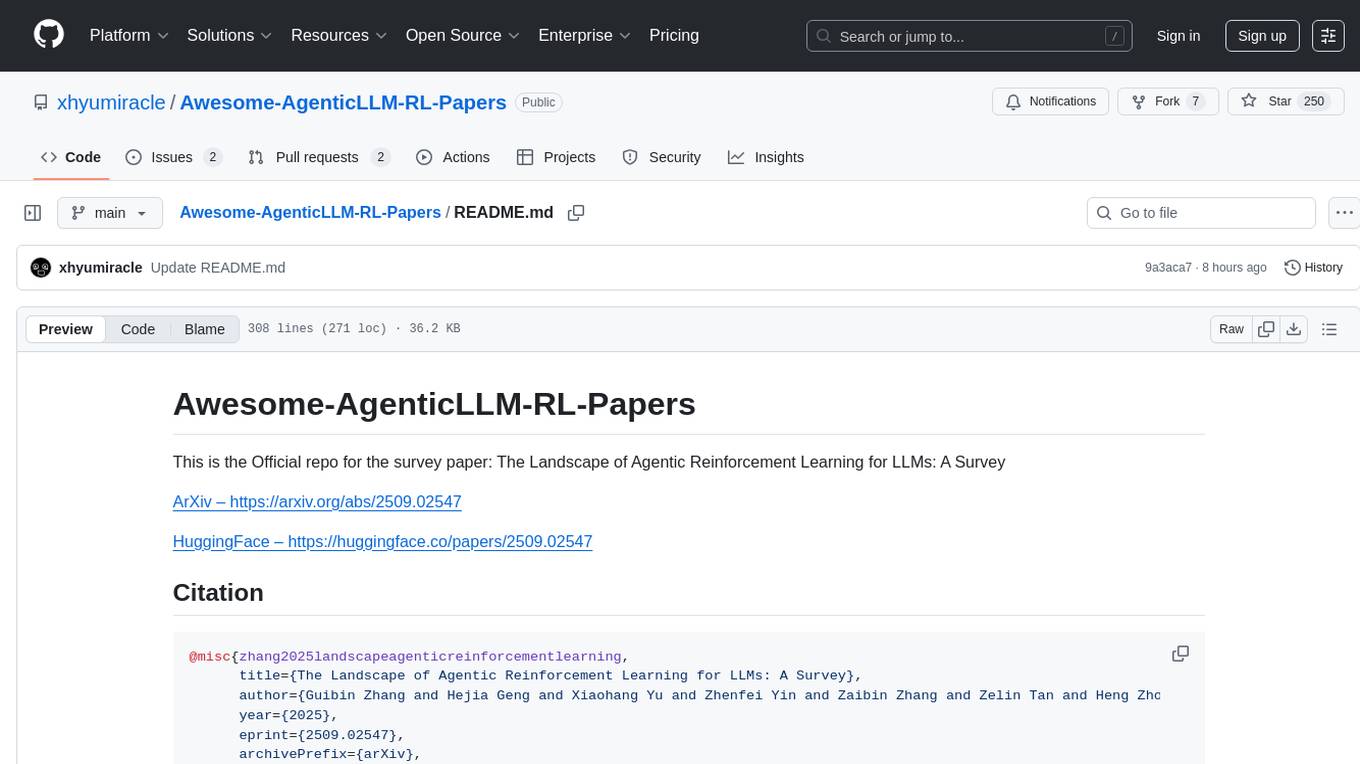
Awesome-AgenticLLM-RL-Papers
This repository serves as the official source for the survey paper 'The Landscape of Agentic Reinforcement Learning for LLMs: A Survey'. It provides an extensive overview of various algorithms, methods, and frameworks related to Agentic RL, including detailed information on different families of algorithms, their key mechanisms, objectives, and links to relevant papers and resources. The repository covers a wide range of tasks such as Search & Research Agent, Code Agent, Mathematical Agent, GUI Agent, RL in Vision Agents, RL in Embodied Agents, and RL in Multi-Agent Systems. Additionally, it includes information on environments, frameworks, and methods suitable for different tasks related to Agentic RL and LLMs.
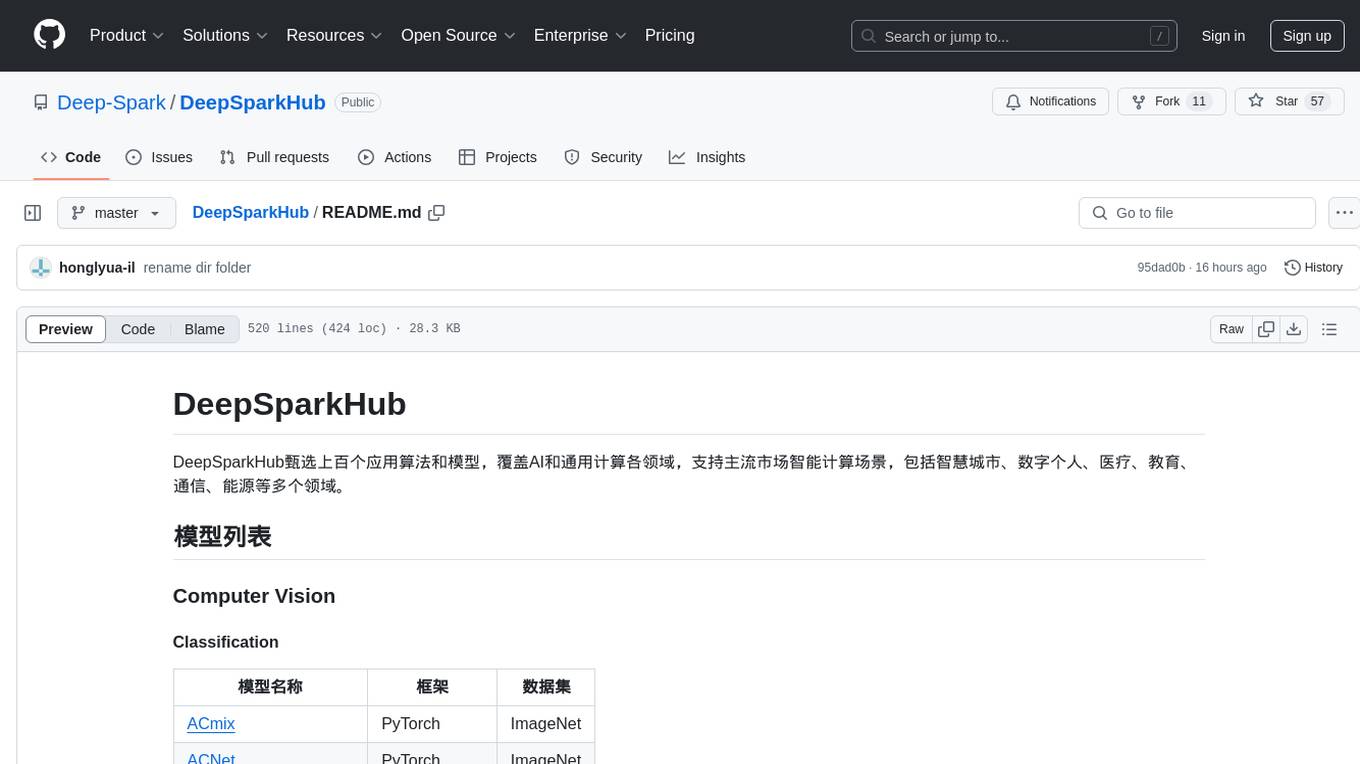
DeepSparkHub
DeepSparkHub is a repository that curates hundreds of application algorithms and models covering various fields in AI and general computing. It supports mainstream intelligent computing scenarios in markets such as smart cities, digital individuals, healthcare, education, communication, energy, and more. The repository provides a wide range of models for tasks such as computer vision, face detection, face recognition, instance segmentation, image generation, knowledge distillation, network pruning, object detection, 3D object detection, OCR, pose estimation, self-supervised learning, semantic segmentation, super resolution, tracking, traffic forecast, GNN, HPC, methodology, multimodal, NLP, recommendation, reinforcement learning, speech recognition, speech synthesis, and 3D reconstruction.
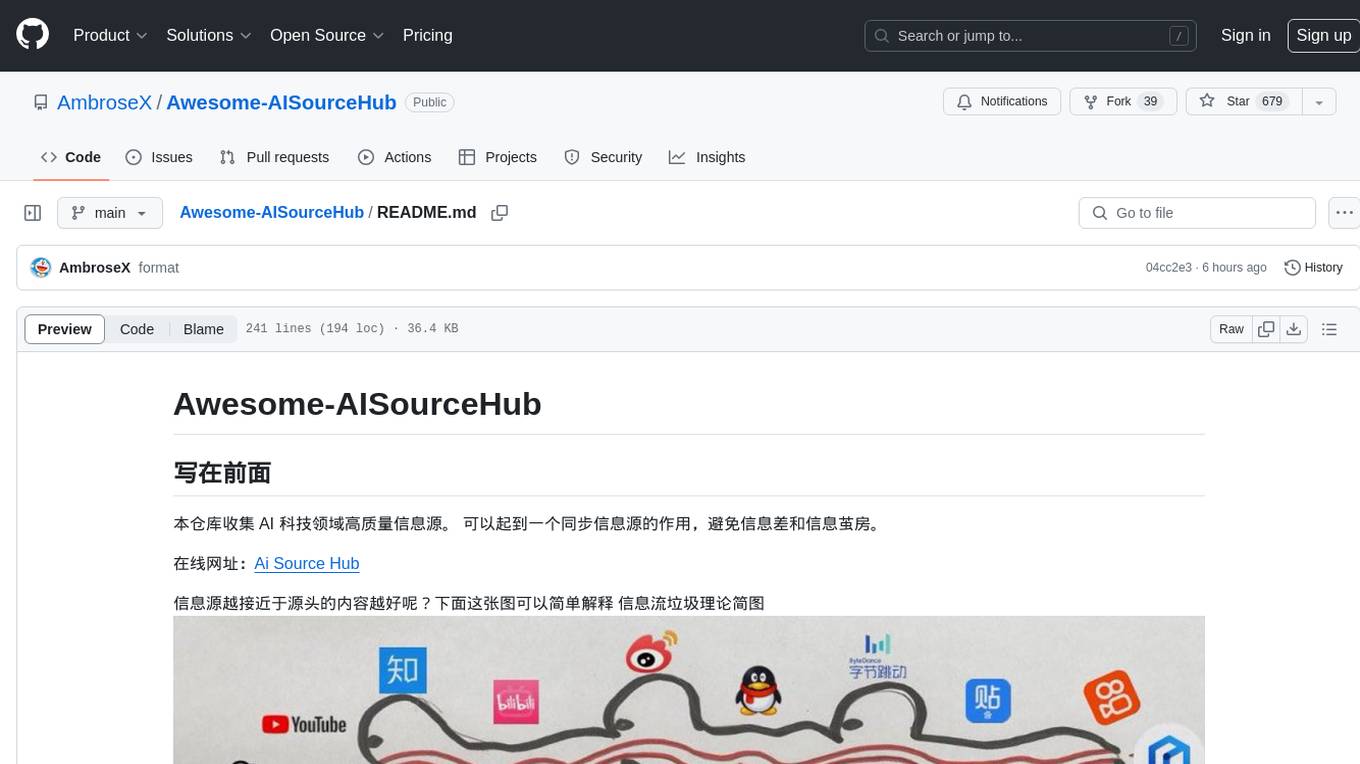
Awesome-AISourceHub
Awesome-AISourceHub is a repository that collects high-quality information sources in the field of AI technology. It serves as a synchronized source of information to avoid information gaps and information silos. The repository aims to provide valuable resources for individuals such as AI book authors, enterprise decision-makers, and tool developers who frequently use Twitter to share insights and updates related to AI advancements. The platform emphasizes the importance of accessing information closer to the source for better quality content. Users can contribute their own high-quality information sources to the repository by following specific steps outlined in the contribution guidelines. The repository covers various platforms such as Twitter, public accounts, knowledge planets, podcasts, blogs, websites, YouTube channels, and more, offering a comprehensive collection of AI-related resources for individuals interested in staying updated with the latest trends and developments in the AI field.
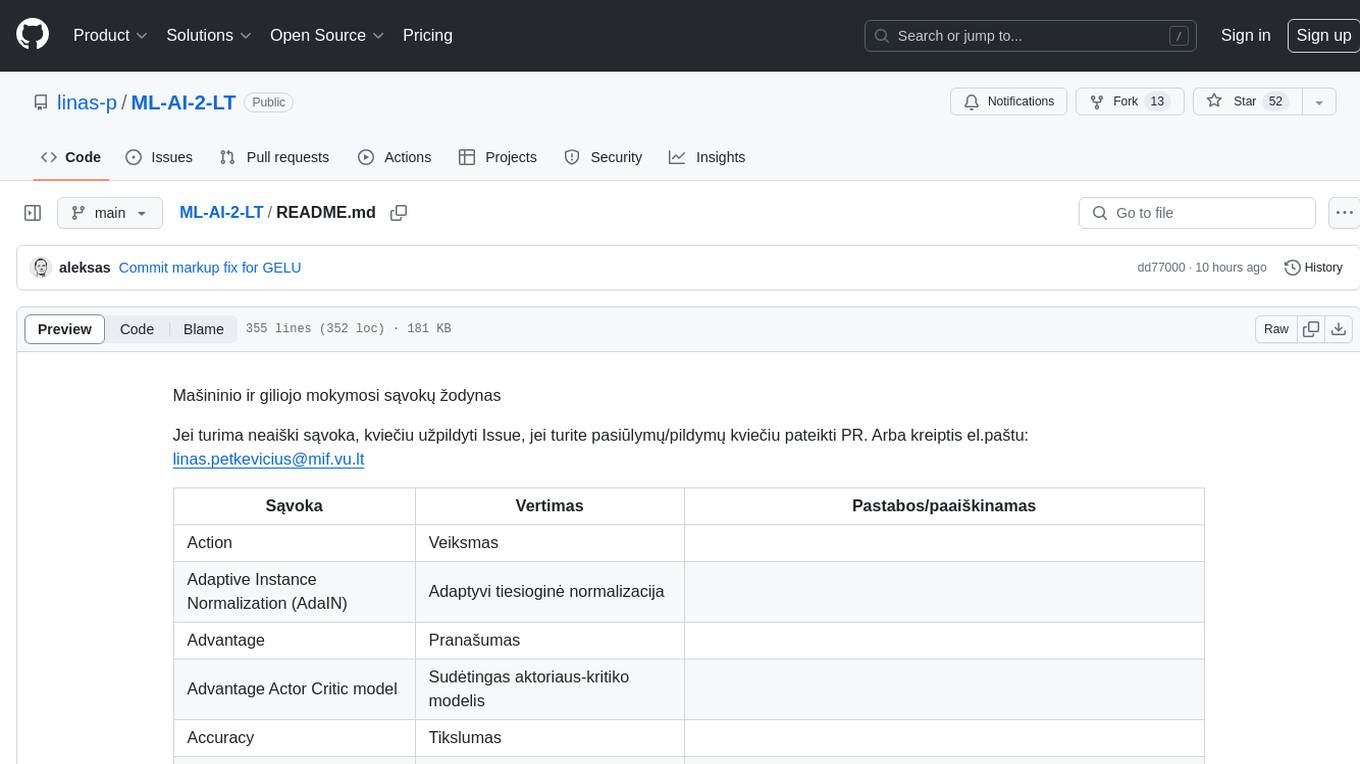
ML-AI-2-LT
ML-AI-2-LT is a repository that serves as a glossary for machine learning and deep learning concepts. It contains translations and explanations of various terms related to artificial intelligence, including definitions and notes. Users can contribute by filling issues for unclear concepts or by submitting pull requests with suggestions or additions. The repository aims to provide a comprehensive resource for understanding key terminology in the field of AI and machine learning.
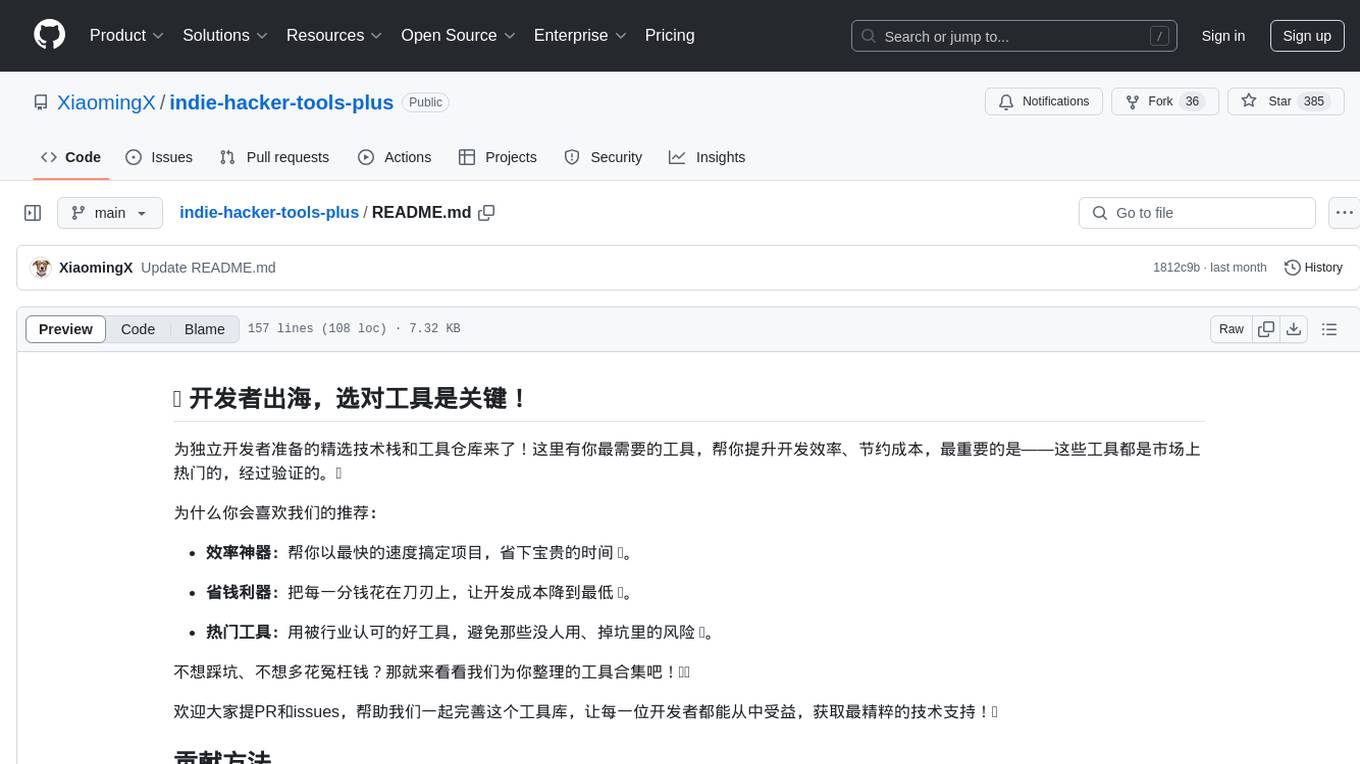
indie-hacker-tools-plus
Indie Hacker Tools Plus is a curated repository of essential tools and technology stacks for independent developers. The repository aims to help developers enhance efficiency, save costs, and mitigate risks by using popular and validated tools. It provides a collection of tools recognized by the industry to empower developers with the most refined technical support. Developers can contribute by submitting articles, software, or resources through issues or pull requests.
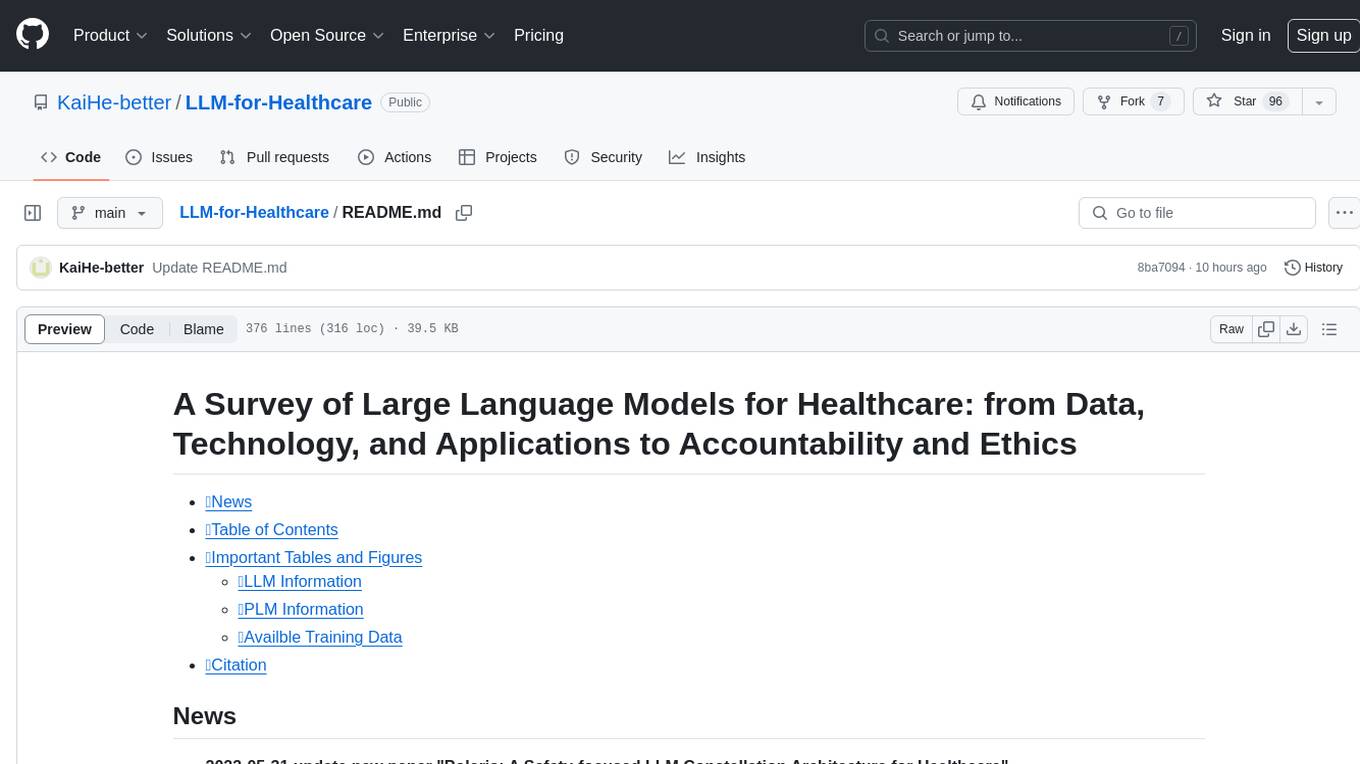
LLM-for-Healthcare
The repository 'LLM-for-Healthcare' provides a comprehensive survey of large language models (LLMs) for healthcare, covering data, technology, applications, and accountability and ethics. It includes information on various LLM models, training data, evaluation methods, and computation costs. The repository also discusses tasks such as NER, text classification, question answering, dialogue systems, and generation of medical reports from images in the healthcare domain.
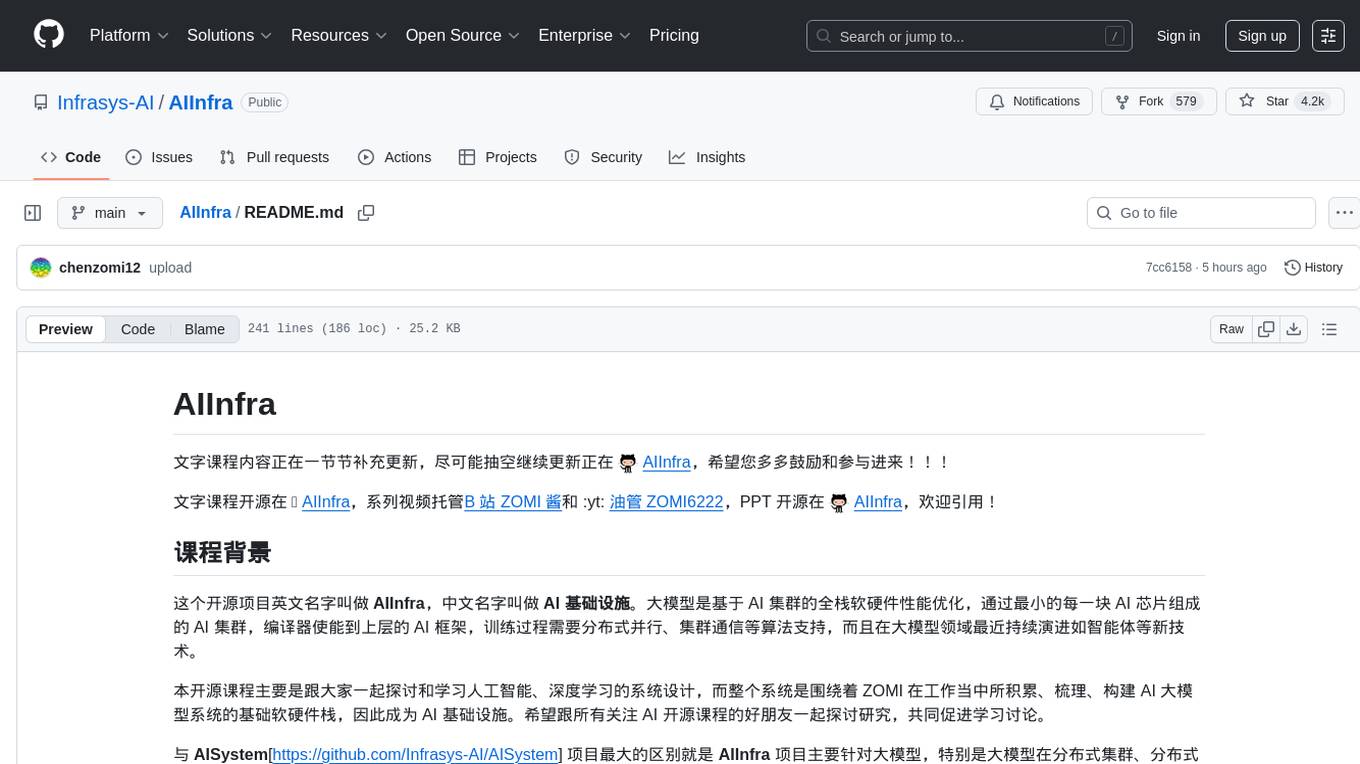
AIInfra
AIInfra is an open-source project focused on AI infrastructure, specifically targeting large models in distributed clusters, distributed architecture, distributed training, and algorithms related to large models. The project aims to explore and study system design in artificial intelligence and deep learning, with a focus on the hardware and software stack for building AI large model systems. It provides a comprehensive curriculum covering key topics such as system overview, AI computing clusters, communication and storage, cluster containers and cloud-native technologies, distributed training, distributed inference, large model algorithms and data, and applications of large models.
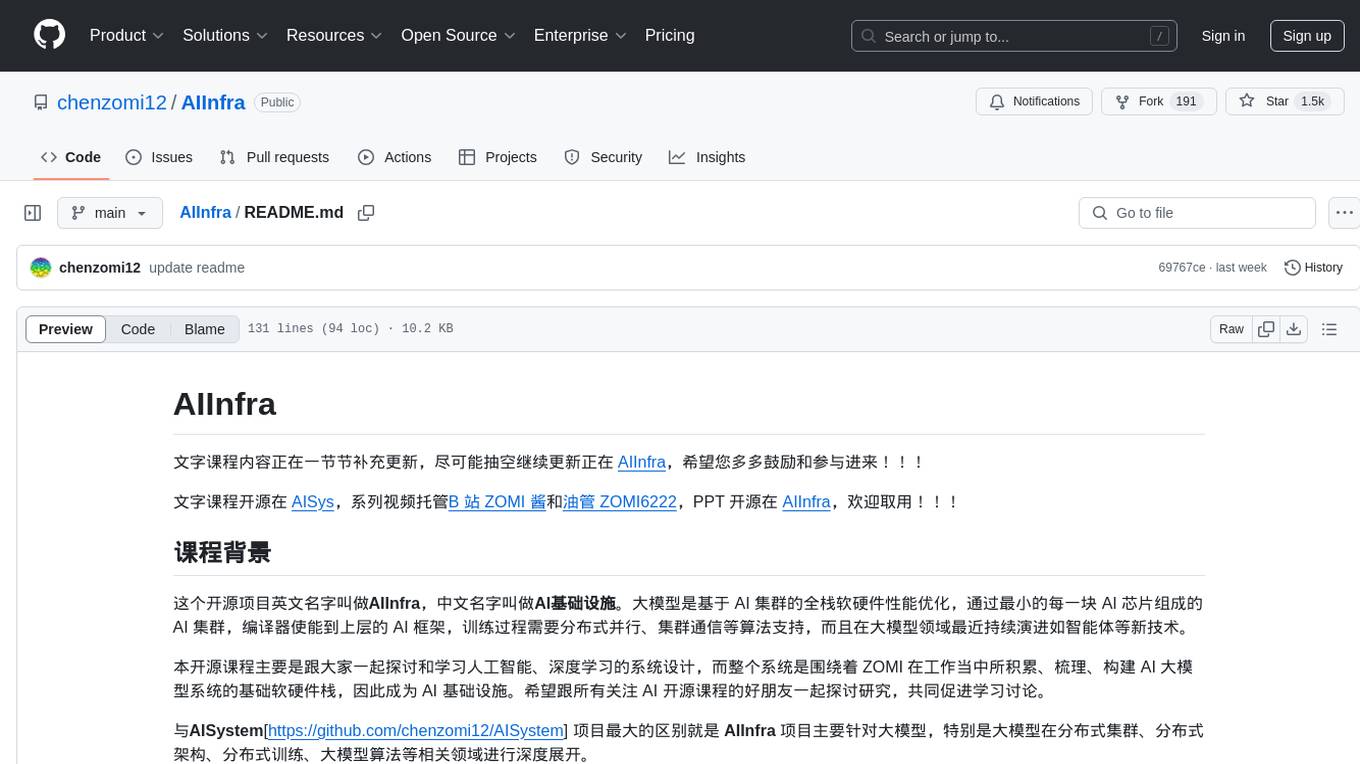
AIInfra
AIInfra is an open-source project focused on AI infrastructure, specifically targeting large models in distributed clusters, distributed architecture, distributed training, and algorithms related to large models. The project aims to explore and study system design in artificial intelligence and deep learning, with a focus on the hardware and software stack for building AI large model systems. It provides a comprehensive curriculum covering topics such as AI chip principles, communication and storage, AI clusters, large model training, and inference, as well as algorithms for large models. The course is designed for undergraduate and graduate students, as well as professionals working with AI large model systems, to gain a deep understanding of AI computer system architecture and design.
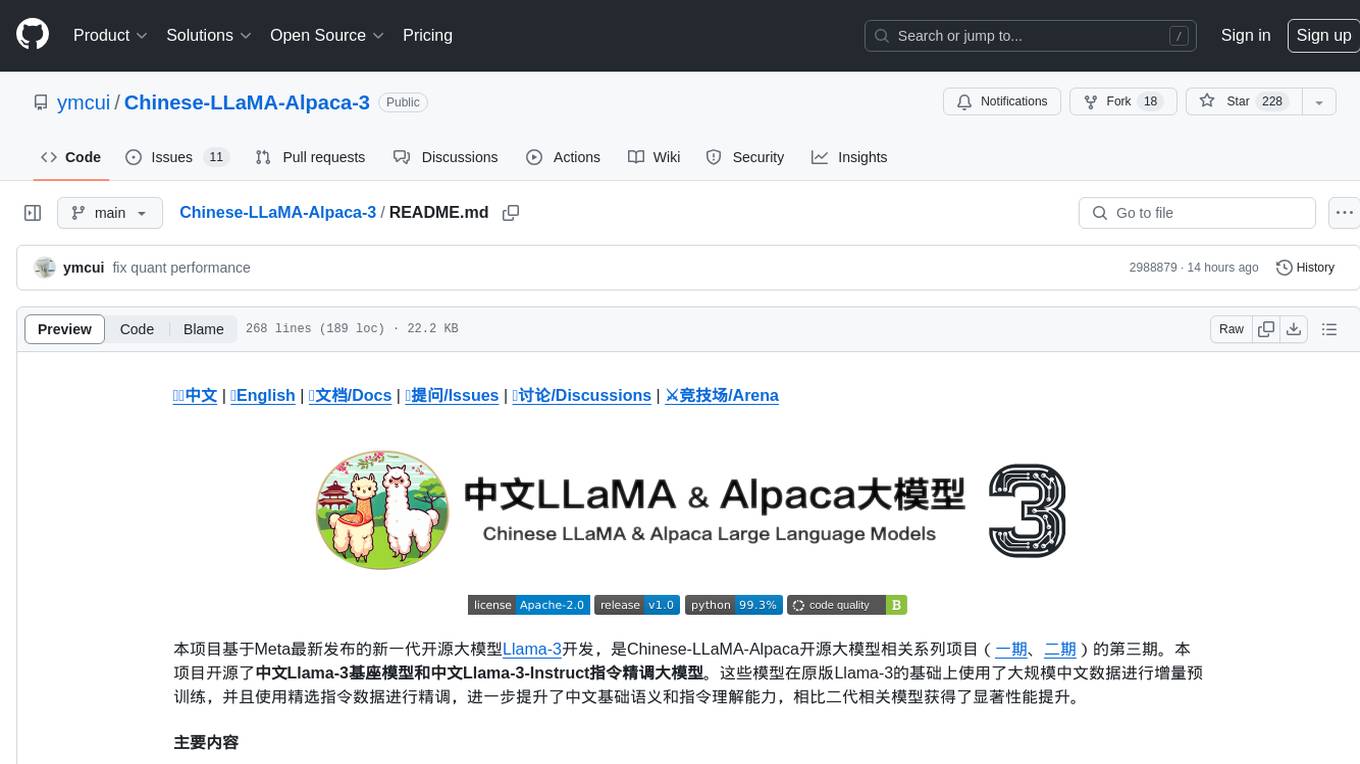
Chinese-LLaMA-Alpaca-3
Chinese-LLaMA-Alpaca-3 is a project based on Meta's latest release of the new generation open-source large model Llama-3. It is the third phase of the Chinese-LLaMA-Alpaca open-source large model series projects (Phase 1, Phase 2). This project open-sources the Chinese Llama-3 base model and the Chinese Llama-3-Instruct instruction fine-tuned large model. These models incrementally pre-train with a large amount of Chinese data on the basis of the original Llama-3 and further fine-tune using selected instruction data, enhancing Chinese basic semantics and instruction understanding capabilities. Compared to the second-generation related models, significant performance improvements have been achieved.
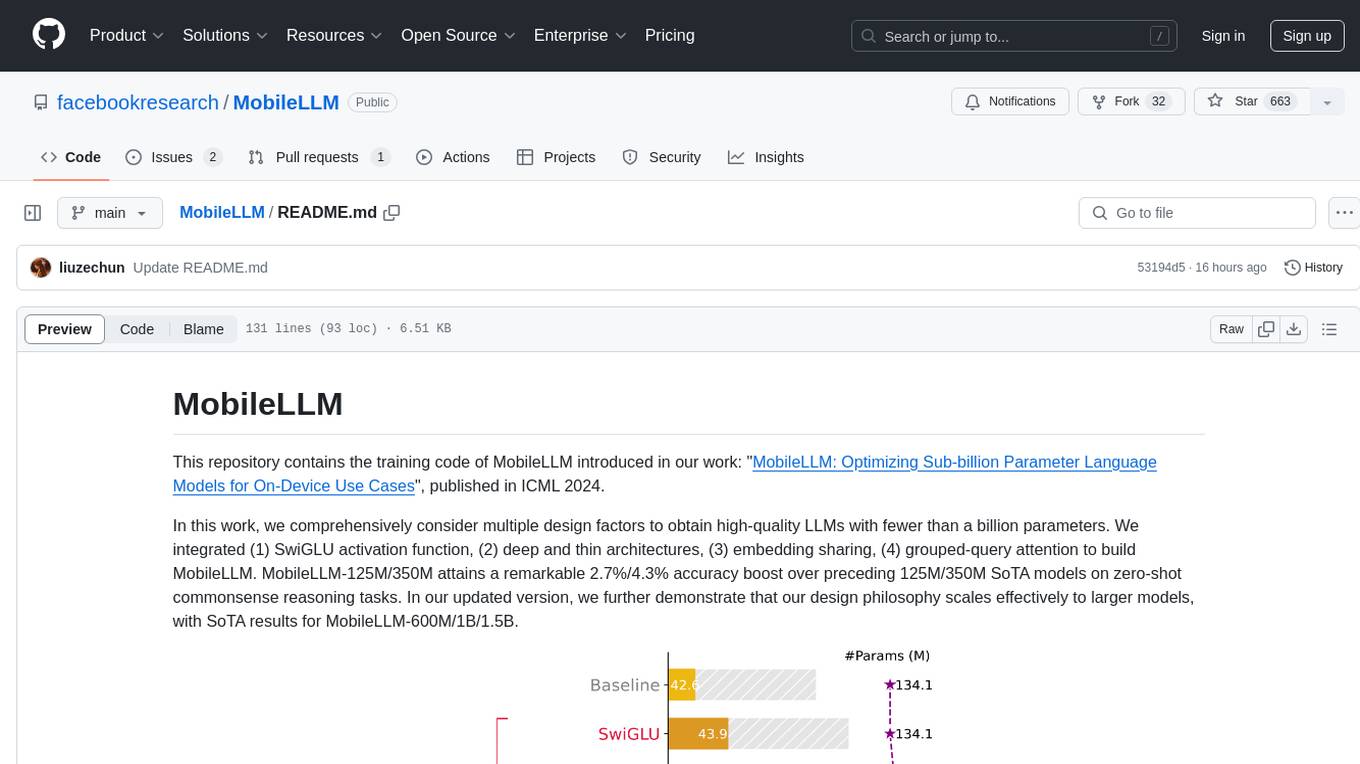
MobileLLM
This repository contains the training code of MobileLLM, a language model optimized for on-device use cases with fewer than a billion parameters. It integrates SwiGLU activation function, deep and thin architectures, embedding sharing, and grouped-query attention to achieve high-quality LLMs. MobileLLM-125M/350M shows significant accuracy improvements over previous models on zero-shot commonsense reasoning tasks. The design philosophy scales effectively to larger models, with state-of-the-art results for MobileLLM-600M/1B/1.5B.
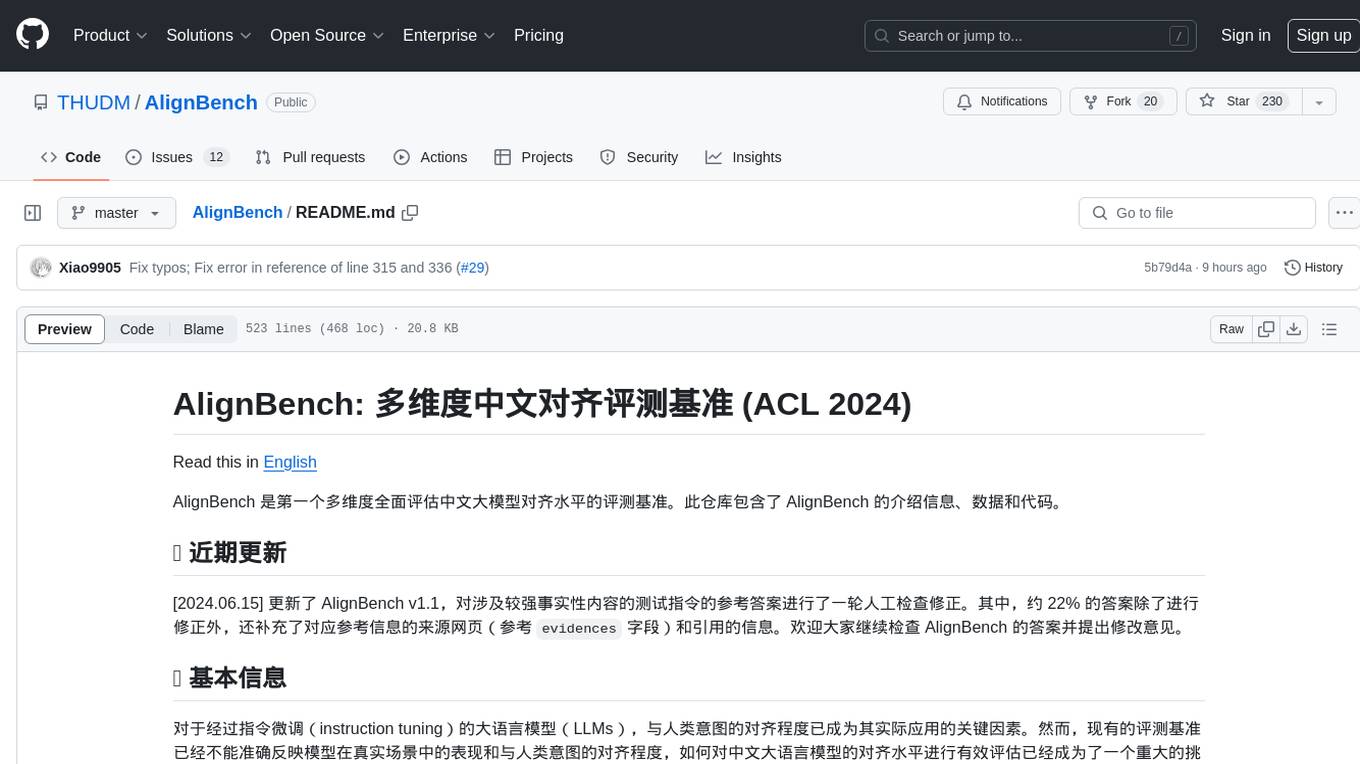
AlignBench
AlignBench is the first comprehensive evaluation benchmark for assessing the alignment level of Chinese large models across multiple dimensions. It includes introduction information, data, and code related to AlignBench. The benchmark aims to evaluate the alignment performance of Chinese large language models through a multi-dimensional and rule-calibrated evaluation method, enhancing reliability and interpretability.
For similar tasks

Awesome-AGI
Awesome-AGI is a curated list of resources related to Artificial General Intelligence (AGI), including models, pipelines, applications, and concepts. It provides a comprehensive overview of the current state of AGI research and development, covering various aspects such as model training, fine-tuning, deployment, and applications in different domains. The repository also includes resources on prompt engineering, RLHF, LLM vocabulary expansion, long text generation, hallucination mitigation, controllability and safety, and text detection. It serves as a valuable resource for researchers, practitioners, and anyone interested in the field of AGI.
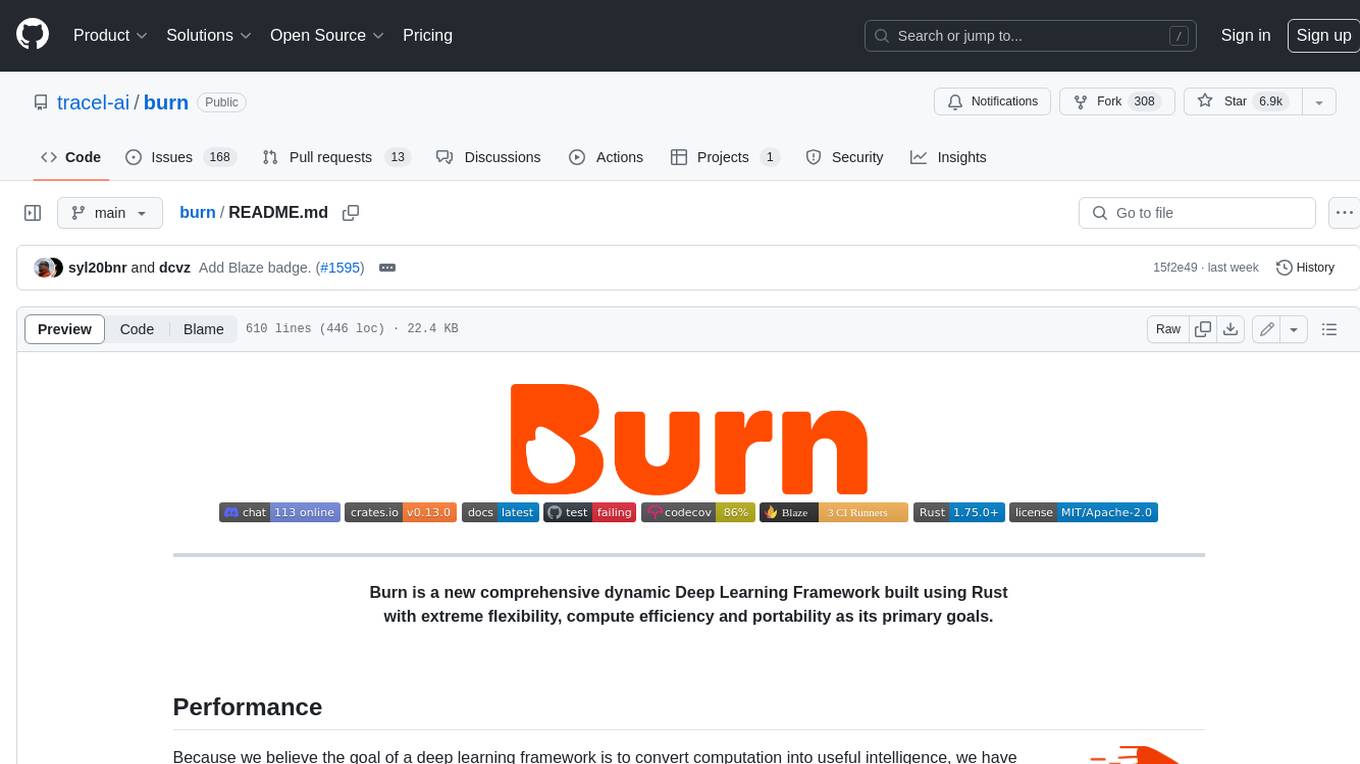
burn
Burn is a new comprehensive dynamic Deep Learning Framework built using Rust with extreme flexibility, compute efficiency and portability as its primary goals.
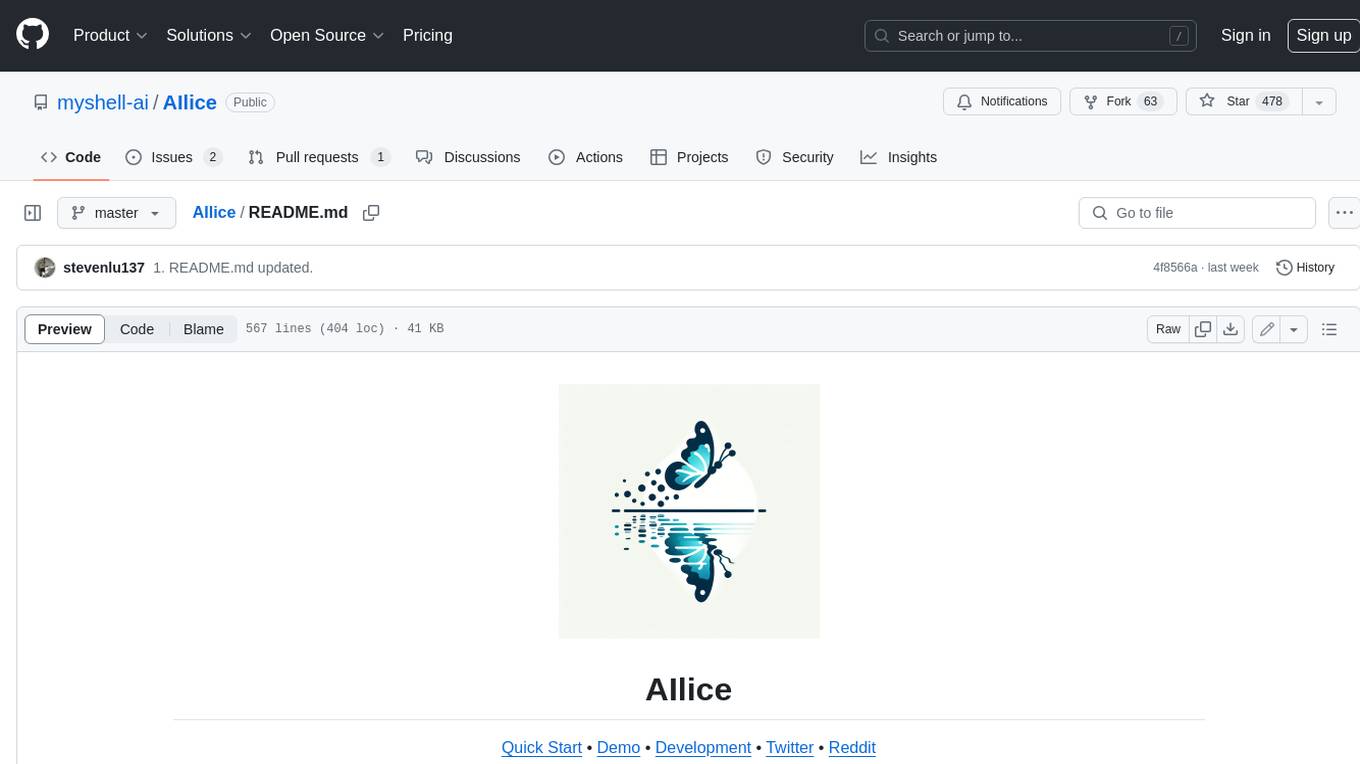
AIlice
AIlice is a fully autonomous, general-purpose AI agent that aims to create a standalone artificial intelligence assistant, similar to JARVIS, based on the open-source LLM. AIlice achieves this goal by building a "text computer" that uses a Large Language Model (LLM) as its core processor. Currently, AIlice demonstrates proficiency in a range of tasks, including thematic research, coding, system management, literature reviews, and complex hybrid tasks that go beyond these basic capabilities. AIlice has reached near-perfect performance in everyday tasks using GPT-4 and is making strides towards practical application with the latest open-source models. We will ultimately achieve self-evolution of AI agents. That is, AI agents will autonomously build their own feature expansions and new types of agents, unleashing LLM's knowledge and reasoning capabilities into the real world seamlessly.
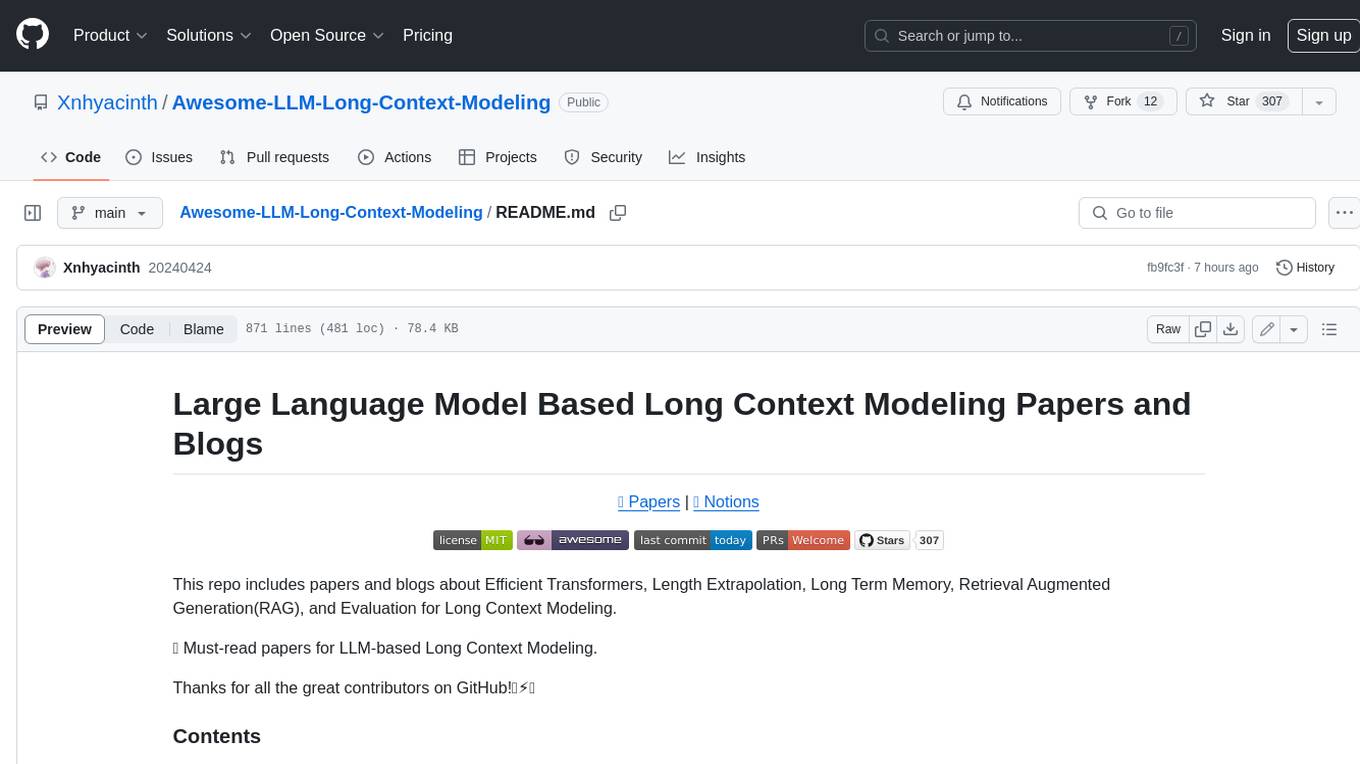
Awesome-LLM-Long-Context-Modeling
This repository includes papers and blogs about Efficient Transformers, Length Extrapolation, Long Term Memory, Retrieval Augmented Generation(RAG), and Evaluation for Long Context Modeling.
For similar jobs

weave
Weave is a toolkit for developing Generative AI applications, built by Weights & Biases. With Weave, you can log and debug language model inputs, outputs, and traces; build rigorous, apples-to-apples evaluations for language model use cases; and organize all the information generated across the LLM workflow, from experimentation to evaluations to production. Weave aims to bring rigor, best-practices, and composability to the inherently experimental process of developing Generative AI software, without introducing cognitive overhead.

agentcloud
AgentCloud is an open-source platform that enables companies to build and deploy private LLM chat apps, empowering teams to securely interact with their data. It comprises three main components: Agent Backend, Webapp, and Vector Proxy. To run this project locally, clone the repository, install Docker, and start the services. The project is licensed under the GNU Affero General Public License, version 3 only. Contributions and feedback are welcome from the community.

oss-fuzz-gen
This framework generates fuzz targets for real-world `C`/`C++` projects with various Large Language Models (LLM) and benchmarks them via the `OSS-Fuzz` platform. It manages to successfully leverage LLMs to generate valid fuzz targets (which generate non-zero coverage increase) for 160 C/C++ projects. The maximum line coverage increase is 29% from the existing human-written targets.

LLMStack
LLMStack is a no-code platform for building generative AI agents, workflows, and chatbots. It allows users to connect their own data, internal tools, and GPT-powered models without any coding experience. LLMStack can be deployed to the cloud or on-premise and can be accessed via HTTP API or triggered from Slack or Discord.

VisionCraft
The VisionCraft API is a free API for using over 100 different AI models. From images to sound.

kaito
Kaito is an operator that automates the AI/ML inference model deployment in a Kubernetes cluster. It manages large model files using container images, avoids tuning deployment parameters to fit GPU hardware by providing preset configurations, auto-provisions GPU nodes based on model requirements, and hosts large model images in the public Microsoft Container Registry (MCR) if the license allows. Using Kaito, the workflow of onboarding large AI inference models in Kubernetes is largely simplified.

PyRIT
PyRIT is an open access automation framework designed to empower security professionals and ML engineers to red team foundation models and their applications. It automates AI Red Teaming tasks to allow operators to focus on more complicated and time-consuming tasks and can also identify security harms such as misuse (e.g., malware generation, jailbreaking), and privacy harms (e.g., identity theft). The goal is to allow researchers to have a baseline of how well their model and entire inference pipeline is doing against different harm categories and to be able to compare that baseline to future iterations of their model. This allows them to have empirical data on how well their model is doing today, and detect any degradation of performance based on future improvements.

Azure-Analytics-and-AI-Engagement
The Azure-Analytics-and-AI-Engagement repository provides packaged Industry Scenario DREAM Demos with ARM templates (Containing a demo web application, Power BI reports, Synapse resources, AML Notebooks etc.) that can be deployed in a customer’s subscription using the CAPE tool within a matter of few hours. Partners can also deploy DREAM Demos in their own subscriptions using DPoC.


